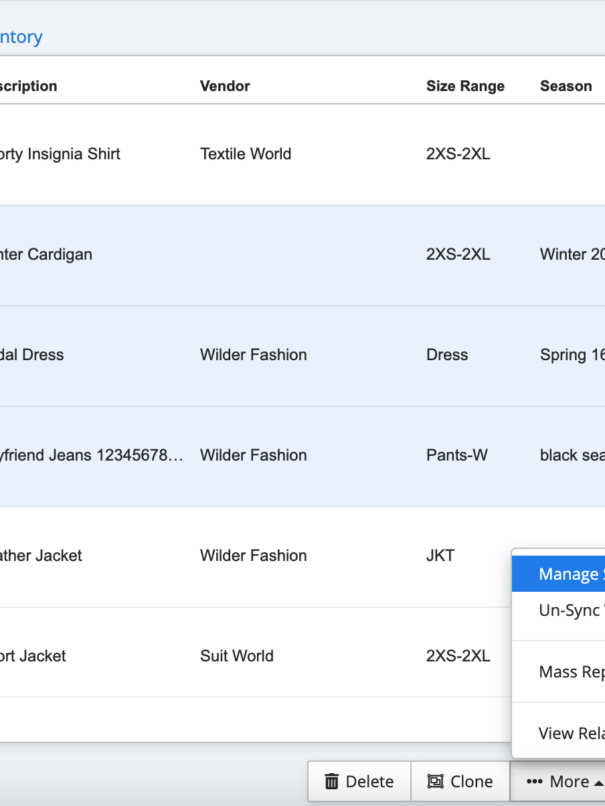The reliability of enterprise resource planning systems has become more significant than ever, especially in the fashion retail sector.
These systems manage everything from supply chain operations to customer data, making them the backbone of the fashion industry.
However, this critical role also makes ERP security a prime focus as cyber-attacks can cause leaks and impact operations. This blog post delves into the challenges of ERP data security in the fashion industry and outlines comprehensive strategies and solutions to mitigate these risks.
The Vulnerability of ERP Systems in Fashion
Data security in ERP systems affects network connections, as well as business operation processes and therefore this process is not without its challenges.
Sensitive Data Management
Fashion ERP systems store a wide range of sensitive information, including customer personal data and financial records. The rich and diverse nature of this data makes these systems particularly attractive for cyber attackers. The management of this sensitive data requires stringent security measures to prevent unauthorized access and data breaches.
Supply Chain Integration
The fashion industry heavily relies on supply chain integration, connecting with numerous suppliers and third-party vendors. This interconnectedness, while beneficial for business operations, also opens up multiple channels for external cyber threats. Each point of integration could potentially serve as an entry point for cybercriminals, making the entire network vulnerable if even one link in the chain is weak or compromised.
Complex User Access
ERP systems in fashion involve various internal departments and external partners, each requiring access to different parts of the system. This complexity in user access management poses significant challenges. Without effective role-based access controls, there’s an increased risk of internal compromise. Properly managing who has access to what information and ensuring that access rights are aligned with job responsibilities is crucial for maintaining the integrity of the system and protecting sensitive data.
To mitigate these vulnerabilities, it’s essential for fashion businesses to implement robust security measures tailored to the unique challenges of their ERP systems. This includes enforcing strong data protection policies, regularly updating security protocols, closely monitoring supply chain networks, and establishing clear access management guidelines. Only through a comprehensive and proactive approach can these vulnerabilities be effectively managed, ensuring the security and reliability of ERP systems in the fast-paced fashion industry.
Challenges in Securing ERP Systems
Ensuring security in ERP is a process fraught with unique challenges:
- Rapid business changes: The fast-paced nature of the fashion industry often means frequent software updates and changes in business processes, making continuous monitoring of ERP systems a challenge.
- Diverse operational needs: From design and manufacturing to marketing and sales, different business units have varied needs, complicating the implementation of a unified security strategy.
- Compliance requirements: The fashion industry often deals with international markets, necessitating compliance with various regional data protection laws.
Comprehensive Strategies for Data Security In ERP Systems
In the fashion industry, securing ERP systems requires a multi-faceted approach that addresses various aspects of data security. The foundation of a strong ERP security strategy includes implementing data security measures like robust data encryption and frequent security updates. This is crucial in safeguarding sensitive information from unauthorized access.
Equally important is the role-based access control (RBAC) system, which ensures that access to the ERP system is based on necessity, significantly reducing the chances of internal data breaches. Multi-factor authentication (MFA) is another layer of security that is particularly vital for remote ERP access, providing an additional safeguard against unauthorized entry.
Continuously monitoring the ERP system and promptly applying security patches plays a pivotal role in defending against new and evolving cyber threats. Alongside this, managing the risks in the supply chain through regular assessments and integrating threat intelligence is essential for identifying and mitigating external risks. However, technology alone isn’t sufficient; human error is a significant security risk. Regular employee training and awareness programs are imperative to educate staff on best practices and the critical importance of data security.
Adopting cloud-based ERP solutions can offer enhanced security features and are often updated more regularly than traditional systems, presenting a more secure option. Lastly, having a well-structured incident response plan is crucial. It ensures that in the event of a security breach, actions are taken swiftly and effectively to minimize any potential damage. Together, these strategies form a comprehensive approach to ERP security, tailored to meet the unique challenges faced by the fashion industry.
Leveraging Technology for Enhanced Security
Enhancing ERP security in today’s digital landscape involves a multifaceted approach, focusing on system, data, and network security. The key strategies for ensuring robust ERP security include:
- System security: This involves protecting the infrastructure and applications that constitute the ERP system. Measures such as firewalls, intrusion detection systems, and antivirus software are essential to defend against external threats. Secure coding, input validation, and patch management are crucial for application layer security. Regular vulnerability assessments and penetration testing are also important to identify and address potential weaknesses.
- ERP data security: Protecting sensitive information within the ERP, such as financial data and personal details of customers and employees, is crucial. Giving role-based access controls, encrypting critical data both at rest and in transit, and establishing secure data handling policies are key measures. Data backup and recovery strategies are vital for restoring data in case of loss or corruption.
- Network security: Since ERP systems often transmit data over networks, securing the network infrastructure is critical to prevent unauthorized access. Putting firewalls, using virtual private networks (VPNs), and granting network access controls are essential. Regular network monitoring and threat detection can help identify and respond to potential security incidents promptly.
In addition to these key elements, addressing human vulnerabilities is crucial. Poor governance, weak access management, and human error are significant security concerns. Educating employees about cybersecurity best practices and implementing strong password policies, including multi-factor authentication, are effective ways to mitigate these risks.
For businesses using cloud-based ERPs, it’s important to understand the shared responsibility model. The cloud provider usually handles infrastructure and application security, while the business is responsible for data flow and employee access controls. Regular software updates and security patches are critical, as outdated software is a common target for cybercriminals.
To effectively manage these aspects, businesses should conduct regular system audits, enforce strict user access control, and have a well-defined security incident response plan. Staying informed about known ERP security issues and collaborating with ERP vendors can provide additional layers of protection.

Conclusion
Ensuring security in ERP processes is not just about safeguarding data; it’s about maintaining consumer trust and ensuring the smooth functioning of business operations. By embracing a comprehensive ERP security strategy, employing the latest technological solutions, and fostering a culture of security awareness, fashion businesses can effectively shield themselves against the ever-evolving landscape of cyber threats.
The journey towards a secure ERP environment is ongoing, but with the right tools and practices, the fashion industry can continue to thrive in an increasingly digital world.







